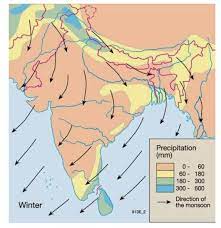The monsoon season in India spans from June to September and this time period is a crucial period for the country’s agriculture and water supply. However, towards the end of the monsoon season, a phenomenon known as the Retreating Monsoon occurs, which has significant effects on the weather and climate of the region. In this article, we will explore the Retreating Monsoon and its impact on India.

Table of Contents
What is the Retreating Monsoon?
It is a weather phenomenon that occurs at the end of the monsoon season in India. During this period, the winds that bring the monsoon rains gradually start to weaken and change direction, resulting in a decrease in rainfall and a shift in weather patterns. It is also known as the Northeast Monsoon.
Causes of Retreating Monsoon
- Changing Pressure Patterns: It is caused by changing pressure patterns over the Indian subcontinent and the surrounding oceans. As the summer monsoon season comes to an end, the high-pressure system over the Indian Ocean shifts eastward, causing the monsoon winds to weaken and reverse direction.
- Movement of the Inter-Tropical Convergence Zone (ITCZ): The ITCZ is a zone of low pressure that moves northward during the summer monsoon season and southward during the winter season. As it moves southward, it brings dry weather to the Indian subcontinent.
Effects of Retreating Monsoon on the Coastal Regions in India
- Heavy rainfall: It brings heavy rainfall to the coastal regions of India, particularly the eastern coast. This can lead to flooding, landslides, and other hazards.
- Strong Winds: The retreating monsoon winds can be strong, particularly along the coasts of Tamil Nadu, Andhra Pradesh, and Odisha. These winds can cause damage to buildings, trees, and other structures.
- Coastal Erosion: It can cause coastal erosion, particularly in areas where there is already significant erosion. This can lead to loss of land and damage to infrastructure.
- Fishing: The retreating monsoon can affect fishing activities in the coastal regions of India. The strong winds and heavy rainfall can make it difficult for fishermen to go out to sea, and the changing weather patterns can affect fish migration and availability.
- Tourism: It can also affect tourism in the coastal regions of India. The heavy rainfall and strong winds can make it difficult for tourists to enjoy the beaches and other attractions.
In summary, the retreating monsoon can have significant effects on the coastal regions of India, including heavy rainfall, strong winds, coastal erosion, fishing, and tourism. It is important for the government and local communities to take measures to mitigate the impacts of the retreating monsoon and protect the people and infrastructure in the affected regions.
Impacts
The Retreating Monsoon has a significant impact on the weather and climate of India. It brings about a change in the wind patterns, resulting in a shift in the weather conditions. The decrease in rainfall during this period affects the agriculture and water supply of the region. Farmers in India rely heavily on the monsoon rains to water their crops, and a decrease in rainfall can result in crop failure and lower yields.
The Retreating Monsoon also brings about a change in temperature and humidity levels. The days become cooler and drier, while the nights become longer and colder. The decrease in humidity levels during this period can cause respiratory problems and skin dryness in some people.
The Retreating Monsoon also has a significant impact on the coastal regions of India. During this period, the sea becomes rough, and there is an increased risk of cyclones and storms. The fishermen who rely on the sea for their livelihood are often affected by these weather conditions.
Conclusion
In conclusion, the Retreating Monsoon is a crucial weather phenomenon that affects India’s weather and climate. It brings about a change in wind patterns, temperature, and humidity levels. The decrease in rainfall during this period affects agriculture, water supply, and coastal regions.
Important Links